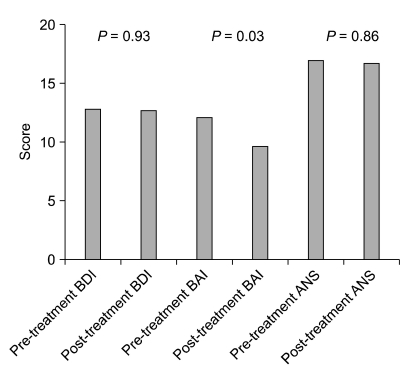Korean J Pain.
2012 Jan;25(1):28-32. 10.3344/kjp.2012.25.1.28.
Efficacy of Glycopyrrolate in Primary Hyperhidrosis Patients
- Affiliations
-
- 1Department of Anesthesiology and Pain Medicine, Ajou University College of Medicine, Suwon, Korea. anekinndo@naver.com
- 2Kichan Pain clinic, Seoul, Korea.
- KMID: 2278112
- DOI: http://doi.org/10.3344/kjp.2012.25.1.28
Abstract
- BACKGROUND
Primary hyperhidrosis is a disorder of excessive sweating, which shares several features with anxiety disorders and has a negative impact on a patient's quality of life. Oral glycopyrrolate is one of the treatments available. There are a few published studies on the use of glycopyrrolate given orally in the treatment of hyperhidrosis.
METHODS
Thies is study was a review of case notes in a series of 36 patients with primary hyperhidrosis. We made a comparison between the Keller's scale score of a pre-glycopyrrolate medication group and the Keller's scale score f a post-glycopyrrolate medication group. The Milanez de Campos score, Short Form_36 (SF-36) score, Beck Depression Inventory (BDI) score, Beck Anxiety Inventory (BAI) score, and autonomic nervous system (ANS) scale score were also compared between the two groups.
RESULTS
In the post-glycopyrrolate medication group, there were declines in Keller's scale, and Milanez de Campos scale score and BAI score (P < 0.001). In addition, there were increases in SF_36 score in the post-glycopyrrolate medication group (P = 0.03) However, no changes were seen in, BDI score and ANS score in the post-glycopyrrolate medication group (P < 0.001).
CONCLUSIONS
Glycopyrrolate is an effective initial method of treating primary hyperhidrosis that, reduces anxiety and improve patients' quality of life.
MeSH Terms
Figure
Reference
-
1. Henteleff HJ, Kalavrouziotis D. Evidence-based review of the surgical management of hyperhidrosis. Thorac Surg Clin. 2008; 18:209–216. PMID: 18557593.
Article2. Klaber M, Catterall M. Treating hyperhidrosis. Anticholinergic drugs were not mentioned. BMJ. 2000; 321:703. PMID: 11202933.3. Naumann M, Lowe NJ. Botulinum toxin type A in treatment of bilateral primary axillary hyperhidrosis: randomised, parallel group, double blind, placebo controlled trial. BMJ. 2001; 323:596–599. PMID: 11557704.
Article4. Kim WO, Yoon DM, Kil HK, Kim JI, Choi BI. Effect of oral glycopyrrolate in essential hyperhidrosis. Korean J Anesthesiol. 2004; 46:298–301.
Article5. Craven JL, Rodin GM, Littlefield C. The Beck Depression Inventory as a screening device for major depression in renal dialysis patients. Int J Psychiatry Med. 1988; 18:365–374. PMID: 3235282.
Article6. Leyfer OT, Ruberg JL, Woodruff-Borden J. Examination of the utility of the Beck Anxiety Inventory and its factors as a screener for anxiety disorders. J Anxiety Disord. 2006; 20:444–458. PMID: 16005177.
Article7. McHorney CA, Ware JE Jr, Raczek AE. The MOS 36-Item Short-Form Health Survey (SF-36): II. Psychometric and clinical tests of validity in measuring physical and mental health constructs. Med Care. 1993; 31:247–263. PMID: 8450681.8. Ro KM, Cantor RM, Lange KL, Ahn SS. Palmar hyperhidrosis: evidence of genetic transmission. J Vasc Surg. 2002; 35:382–386. PMID: 11854739.
Article9. Ruchinskas R. Hyperhidrosis and anxiety: chicken or egg? Dermatology. 2007; 214:195–196. PMID: 17377378.
Article10. Bugmann P, Robert J, Magistris M, Le Coultre C. Thoracoscopic sympathectomy using ultrasonic coagulating shears: a technical improvement in the treatment of palmar hyperhidrosis. Pediatr Surg Int. 2002; 18:746–748. PMID: 12598981.
Article11. Reisfeld R. One-year follow-up after thoracoscopic sympathectomy for hyperhidrosis. Ann Thorac Surg. 2007; 83:358–359. PMID: 17184714.
Article12. Adams BB, Vargus-Adams JN, Franz DN, Kinnett DG. Hyperhidrosis in pediatric spinal cord injury: a case report and gabapentin therapy. J Am Acad Dermatol. 2002; 46:444–446. PMID: 11862186.
Article
- Full Text Links
- Actions
-
Cited
- CITED
-
- Close
- Share
- Similar articles
-
- Effect of Oral Glycopyrrolate in Essential Hyperhidrosis
- Effectiveness of Oral Glycopyrrolate Use in Compensatory Hyperhidrosis Patients
- A Treatment Experience of Focal Hyperhidrosis in Sacrococcygeal Region: A report of two cases
- Treatment of Compensatory Gustatory Hyperhidrosis with Topical Glycopyrrolate
- Dose Thoracoscopic Sympathectomy for Hyperhidrosis Increase Airway Pressure?




